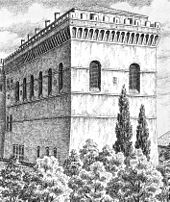Baccio Pontelli

Baccio Pontelli(c. 1449 – c. 1494) was an Italian architect and worker in wood inlays, who designed theSistine ChapelinVatican City.Baccio is an abbreviation of Bartolomeo.
Pontelli was born inFlorence;in 1459 his father declared he was ten years old.[1]He trained in artistic woodwork such asmarquetryin the workshop ofGiulianoandBenedetto da Maianoin Florence, and was influenced byFrancesco di Giorgio Martiniduring a trip to Urbino (1480–1482), where he worked on theStudioloof DukeFederico de Montefeltro,in thePalazzo Ducale, Urbino.He worked in Florence and later in Urbino on inlays.
Acting as an architect inRome,he participated in the popeSixtus IV's urban renewal. His exact contributions are unclear; he was perhaps more given more work supervising construction than designing. The tendency ofGiorgio Vasarito attribute most Papal building commissions in the period to his fellow-Florentine has rather confused matters.[2]That said, his projects included:Santa Aureaand fortifications inOstia;thePonte Sistoin Rome; the hospital ofSanto Spirito in Sassia;the churchSant'Agostino;the facade ofSanta Maria del Popolo;San Pietro in Vincoli;Santi Apostoliand design for theSistine Chapel.
In the last years of his life he worked in theMarcheregion on the military fortresses ofAcquaviva PicenaJesi,OsimoandSenigallia.In 1494 he is recorded working at various places in theKingdom of Naples.[3]He died atUrbinoand is buried in the church of St Dominicitthere, where a nephew placed an epitaph in 1577.[4]

Notes
[edit]References
[edit]- Gritti, Jessica,"Pontelli, Bacio",Dizionario Biografico degli Italiani - Volume 84 (2015)(online at Traccani, in Italian)
- Milizia, Francesco (1797).Dizionario delle Belle Arti del Disegno y Estratto in Gran Parte dalla Enciclopedia Metodica da Francesco Milizia, Seconda Edizione, Tomo Secondo.Bassano, Italy. p. 114.
